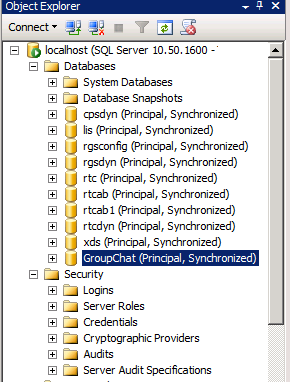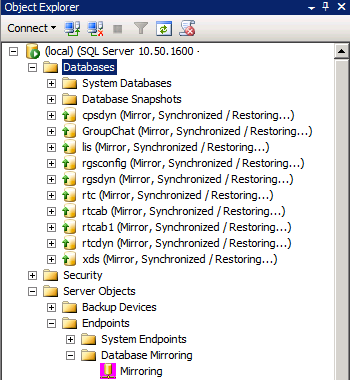In previous posts in this series on Lync Server 2010 and SQL Mirroring I’ve covered the prerequisites, how to failover your SQL databases and how the backend Lync databases behave once you’ve failed over. In this final post, I’m going to cover how Group Chat behaves when it’s database is mirrored and subsequently failed over.
As with my other posts regarding SQL mirroring and Lync Server 2010, I must stress that this is completely unsupported by Microsoft. I attempted this deployment scenario purely as a “could it be done” exercise only. Do not take this as gospel and do not deploy it in a production environment.
Preparing the DR scenario
So the first thing we need to do is get everything setup to support Group Chat in the DR site. This involves mirroring the Group Chat database between the Principal and Mirror SQL server nodes in each site and ensuring the SQL mirror node is setup to allow a Group Chat server to connect to it.
Mirroring the Group Chat database and preparing the SQL Mirror node
I covered this in the prerequisites post, so we can assume that we’ve followed the steps to mirror the Group Chat database already.
But before we can failover the Group Chat database, we need to make sure the mirror node is setup so the Group Chat Server can connect to it. To do this, we need to make sure security is setup on the SQL server mirror node to support Group Chat. TechNet covers the steps required to do this throughly in this article, so all your need to do is follow the steps listed on your SQL mirror node.
Setting up a standby Group Chat server
The first caveat to throw in the mix here is that to bring up Group Chat in the DR site, you mustn’t actually have the Group Chat server setup already. This is because Group Chat topologies come in either single or multiple server flavours, so if it were already part of the topology it would be used by users. In this scenario, we want to keep this server as a standby and not used when the production site is online.
The server you’ll be using for Group Chat will need to be a cold standby machine in DR that already has a certificate issued to it for its FQDN and the Group Chat prerequisites installed. Once this is setup, it’s ready to have Group Chat installed on it when you need to activate your DR plan.
Activating Group Chat in the DR site
So once you’ve failed over your database and made the SQL mirror node the Principal, it’s time to get Group Chat up and running again in your DR site. To do this, you essentially need to remove the Group Chat server you had in the primary site because a 1:1 to relationship exists between a Group Chat server/pool and a Lync Server 2010 registrar (Standard Edition server or Enterprise Edition pool). Additionally, the server we’ll have prepared in the DR site will have a different server name.
Cleaning the Lync Topology
Firstly we need to remove the old Group Chat server from the Lync topology. This involves running the following cmdlets:
Remove-CsTrustedApplicationPool -identity <FQDN of failed Group Chat server>
Remove-CsTrustedApplication -identity <FQDN of failed Group Chat server>
These cmdlets will remove references to the failed Group Chat server from your Lync topology, allowing you to spin up a new Group Chat server in the DR site. If we leave the old Group Chat server in the topology, when we try to add a new server in DR it picks up this configuration automatically and we can’t define a new next hop pool.
Making a hosts file change
Next we need to make a local hosts file change so that the FQDN of the principal SQL server resolves to the IP address of the mirror SQL server in the DR site.
We need to do this because although the Group Chat services are somewhat SQL mirroring aware (I witnessed a connection from my Group Chat server to my SQL mirror node on TCP port 1433 after I failed over), the good news doesn’t last and eventually the Lookup and Channel services stop functioning. Modifying the hosts file overcomes this and the services stay started.
Install Group Chat in the DR site
Now that we’ve cleared references from the topology and our hosts file is modified, we can begin the install of Group Chat in the DR site by installing Group Chat using the Installation Wizard as normal:
- When prompted to provide a SQL server and instance name, provide the principal SQL server name and the Group Chat database name. Once we commit this configuration, it will write new rows to the tbl.Config table in the Group Chat database to allow this Group Chat Lookup/Channel server to work.
- When prompted at the next screen, assign the previously imported certificate to the new Group Chat Server.
- Following this screen you will see the next hop address and site. These will all be greyed out because the tbl.Config database has already been populated with them. We’ll fix this in step 5.
- Once deployment has completed, ensure all Group Chat services start. If some services fail to start, consult the local Lync Server event log and troubleshoot SQL database access.
- Next, using the Server Config Tool, set the next hop Lync pool that Group Chat is configured with to the FQDN of the DR Lync Standard Edition server or Enterprise Edition pool. This will modify the tbl.Config table for us in the SQL database.
Once you’ve got Group Chat installed, you will want to run Get-CsTrustedApplicationPool to ensure the Lync topology has been updated with the new Group Chat server details so your FE pool in DR can talk to it.
Validation and Summary
Once you’ve followed the steps above, you’ll want to fire up your Group Chat client and attempt to sign in. If you can’t sign in straight away, check that your Group Chat services are started ok and that a Trusted Application pool exists in Lync for your DR Group Chat server.
This post (and the series) has really been a “proof of concept” exercise only, but it does show that Group Chat can utilise a mirrored SQL database, with some pretty decent configuration change. As I said, don’t use this blog post as verification when making a design decision around your DR requirements for Lync.
Thanks for following along, I hope this series has helped you understand the challenges around SQL mirroring in Lync in more detail and why Microsoft doesn’t support it.

